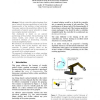1270 search results - page 163 / 254 » Dogged Learning for Robots |
KES
1998
Springer
14 years 2 months ago
1998
Springer
Robotic controllers take advantage from neural network learning capabilities as long as the dimensionality of the problem is kept moderate. This paper explores the possibilities of...
IJCNN
2006
IEEE
14 years 4 months ago
2006
IEEE
– This paper presents a hippocampal inspired robot localization model that provides a means for a simple robotic platform with ultrasonic sensors to localize itself. There have b...
HRI
2006
ACM
14 years 4 months ago
2006
ACM
The essence of the signal-to-symbol problem consists of associating a symbolic description of an object (e.g., a chair) to a signal (e.g., an image) that captures the real object....
RAS
2007
13 years 9 months ago
2007
Abstract— In human-robot communication it is often important to relate robot sensor readings to concepts used by humans. We suggest to use a virtual sensor (one or several physic...
IROS
2006
IEEE
14 years 4 months ago
2006
IEEE
— Being able to localize the origin of a sound is important for our capability to interact with the environment. Humans can localize a sound source in both the horizontal and ver...

